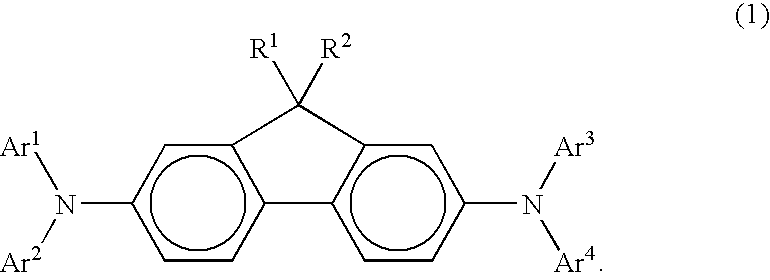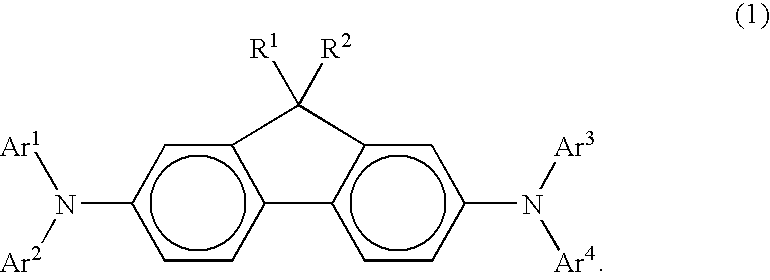Arylamine compound and organic electroluminescence device
a technology of organic electroluminescence and compound, which is applied in the direction of discharge tube luminescnet screen, anthracene dye, natural mineral layered products, etc., can solve the problems of difficult to achieve the luminance of light emission and durability against degradation, and the device exhibiting a sufficiently high luminance for practical application cannot be obtained, etc., to achieve excellent heat resistance, excellent hole transporting property, and high luminance
- Summary
- Abstract
- Description
- Claims
- Application Information
AI Technical Summary
Benefits of technology
Problems solved by technology
Method used
Image
Examples
synthesis example 1 (
Compound (B-1))
[0061]The routes of reactions for synthesizing intermediate compound b and intermediate compound d are shown in the following:
[0062]
Synthesis of Intermediate Compound a
[0063]Into an autoclave, 19.5 g (96 mmole) of pyrene, 7.8 g of Pd / C (5%) and 100 ml of decaline were placed and the reaction was allowed to proceed under a hydrogen pressure of 70 kg / cm2 at 160° C. for 2 hours. After the reaction as completed, the catalyst was removed and the remaining liquid was washed with 300 ml of chloroform. Then, chloroform was removed by distillation under a reduced pressure and the residual decaline solution was cooled with ice. The precipitated crystals were separated by filtration, washed with ethanol and dried by heating and 13 g (the yield: 64%) of intermediate compound a as the object compound was obtained.
Synthesis of Intermediate Compound b
[0064]Intermediate compound a in an amount of 12.6 g (60 mmole) was suspended in 1 liter of purified water and 0.2 g of FeCl3.H2O was ...
synthesis example 2 (
Compound (B-2))
Synthesis of Intermediate Compound e
[0068]The route of the reaction for synthesizing intermediate compound e is shown in the following:
[0069]
[0070]Into a 300 ml three-necked flask equipped with a condenser, 3.7 g (40 mmole) of aniline, 8.2 g (40 mmole) of 1-bromonaphthalene, 1.1 g (1.5% by mole) of tris(dibenzylideneacetone)dipalladium, 0.72 g (3% by mole) of tri-o-tolylphosphine, 3.8 g (40 mmole) of sodium t-butoxide and 100 ml of dry toluene were placed under argon and the resultant mixture was stirred under heating at 100° C. for one night. After the reaction was completed, the precipitated crystals were separated by filtration and washed with 100 ml of methanol and 8.3 g (the yield: 95%) of intermediate compound e was obtained.
Synthesis of Compound (B-2)
[0071]Into a 300 ml three-necked flask equipped with a condenser, 3.6 g (10 mmole) of intermediate compound b, 4.4 g (20 mmole) of intermediate compound e, 0.27 g (1.5% by mole) of tris(dibenzylideneacetone)dipalla...
synthesis example 3 (
Compound (B-3))
Synthesis of Intermediate Compound f
[0072]The route of the reaction for synthesizing intermediate compound f is shown in the following:
[0073]
[0074]Into a 1 liter three-necked flask shielded from light, 12.4 g (50 mmole) of spiro[cyclohexane-1,9′-fluorene]-4-one (Journal of Organic Chemistry 26, 3280 (1961)), 100 ml of chloroform and 0.2 g of FeCl2 were placed. Then, 24 g (0.15 mole) of bromine was added dropwise at 0° C. The reaction was allowed to proceed in the obtained mixture at the room temperature for one night. After the reaction was completed, the precipitated crystals were separated by filtration, washed with water and ethanol and dried by heating and 6.0 g (the yield: 30%) of intermediate compound f as the object compound was obtained.
Synthesis of Compound (B-3)
[0075]Into a 300 ml three-necked flask equipped with a condenser, 4.1 g (10 mmole) of intermediate compound f, 6.4 g (20 mmole) of intermediate compound d, 0.27 g (1.5% by mole) of tris(dibenzylidenea...
PUM
| Property | Measurement | Unit |
|---|---|---|
| thickness | aaaaa | aaaaa |
| luminance | aaaaa | aaaaa |
| temperature | aaaaa | aaaaa |
Abstract
Description
Claims
Application Information
 Login to View More
Login to View More - R&D
- Intellectual Property
- Life Sciences
- Materials
- Tech Scout
- Unparalleled Data Quality
- Higher Quality Content
- 60% Fewer Hallucinations
Browse by: Latest US Patents, China's latest patents, Technical Efficacy Thesaurus, Application Domain, Technology Topic, Popular Technical Reports.
© 2025 PatSnap. All rights reserved.Legal|Privacy policy|Modern Slavery Act Transparency Statement|Sitemap|About US| Contact US: help@patsnap.com



